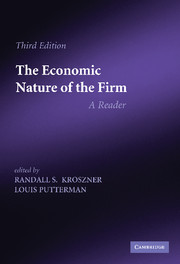Book contents
- Frontmatter
- Contents
- Editors' preface
- Reintroducing The Economic Nature of the Firm
- Part I Within and among firms: the division of labor
- 1 From The Wealth of Nations
- 2 From Capital
- 3 From Risk, Uncertainty, and Profit
- 4 From The Modern Corporation and Private Property
- 5 The use of knowledge in society
- 6 Corporate governance
- Part II The scope of the firm
- Part III The employment relation, the human factor, and internal organization
- Part IV Finance and the control of the firm
- References
- References
6 - Corporate governance
Published online by Cambridge University Press: 05 June 2014
- Frontmatter
- Contents
- Editors' preface
- Reintroducing The Economic Nature of the Firm
- Part I Within and among firms: the division of labor
- 1 From The Wealth of Nations
- 2 From Capital
- 3 From Risk, Uncertainty, and Profit
- 4 From The Modern Corporation and Private Property
- 5 The use of knowledge in society
- 6 Corporate governance
- Part II The scope of the firm
- Part III The employment relation, the human factor, and internal organization
- Part IV Finance and the control of the firm
- References
- References
Summary
While some of the questions have been around since Berle and Means (1932), the term ‘corporate governance’ did not exist in the English language until twenty years ago. In the last two decades, however, corporate governance issues have become important not only in the academic literature, but also in public policy debates. During this period, corporate governance has been identified with takeovers, financial restructuring, and institutional investors' activism. But what exactly is corporate governance? Why is there a corporate governance ‘problem’? Why does Adam Smith's invisible hand not automatically provide a solution? What role do takeovers, financial restructuring, and institutional investors play in a corporate governance system?
When do we need a governance system?
The word ‘governance’ is synonymous with the exercise of authority, direction, and control. These words, however, seem strange when used in the context of a free-market economy. Why do we need any form of authority? Isn't the market responsible for allocating all resources efficiently without the intervention of authority? The basic (neoclassical) undergraduate microeconomics courses rarely mention the words ‘authority’ and ‘control’.
In fact, neoclassical microeconomics describes well only one set of transactions, which Williamson (1985) calls ‘standardized’. Consider, for instance, the purchase of a commodity, like wheat. There are many producers of the same quality of wheat and many potential customers. In this context, Adam Smith's invisible hand ensures that the good is provided efficiently without the need of any form of authority.
- Type
- Chapter
- Information
- The Economic Nature of the FirmA Reader, pp. 69 - 76Publisher: Cambridge University PressPrint publication year: 2009



